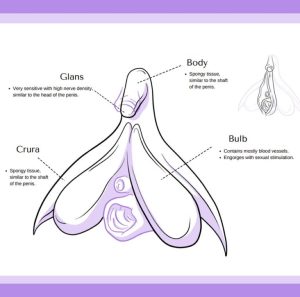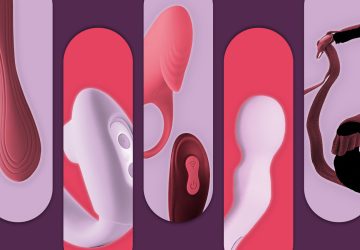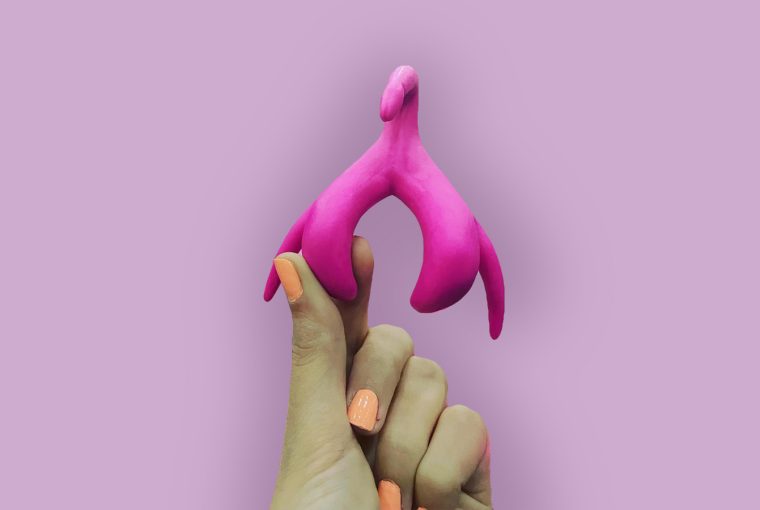Clitorally Crazy: 4 Myths about the Clitoris
There’s a lot of faulty and funky information out there in the sex world. Sometimes it harms us and sometimes it’s fairly neutral. Check out the following four myths about clitorises.

Myth #1: The clitoris is just a little button/nub at the top of the vulva.
Truth: The clitoris, or the full clitoral structure, is shaped like a wishbone with most of the structure being internal. Reports on the size vary but I’ve seen explanations ranging anywhere from 3.5 – 7 inches long. The button/nub is the clitoral glans and is equivalent to the head of a penis and full of fun nerve endings. The whole clitoral structure, which includes the glans, crura, and vestibular bulbs, become erect when aroused, just like a penis. Because of the location, in which the crura and bulbs surround the top half of the vagina, internal stimulation through vaginal penetration stimulates internal parts of the clitoris. Similarly, what is understood as the G-spot region, is hypothesized to be the roots/ends of the clitoris. To read more about the clitoral complex, click here.
What does this mean? Much of vulva and vaginal pleasure is directly related to the clitoris (poor Freud, this debunks his “mature” vs. “immature” orgasm theory). It also means that stimulation of the labia can be pleasurable because of where the legs are located. Lastly, for people who have experienced genital cutting, there may be the option of exposing more of the clitoral glans from below the clitoral hood to regain that type of pleasure as well as the potential to stimulate different parts of the internal clitoris through internal and external play.
Myth #2: Vibrators ruin clitorises.
Truth: I get this question A LOT. People who use vibrators to stimulate their clitoris every time they masturbate may be experiencing one of two things, but neither is a broken clitoris.
The first is temporary desensitization. After using your vibrator for a bit, the area may feel a little numb or non-responsive but that would be true of any area of your body where you maintained deep buzzing. That sensation should alleviate quickly, leaving you available for more clitoral play.
The second concern is that vibrators will ruin you because you won’t be able to orgasm with a partner. First, you can always bring your favorite toys into the bedroom to incorporate into your shared sexy time (though consent is important so chat about it if your partner would be surprised).
Second, you’re right. If you always get off the same way, your body will likely become dependent upon that form of stimulation and have trouble reaching orgasm other ways, including with partners. Thankfully, the solution can be quite fun – diversify your masturbation technique (this is true for people with penises, too)! Try masturbating yourself with your fingers, a showerhead, or a different toy than the one you’re used to. Take your time and savor the sensations. It may be challenging at first and even tempting to return to your trusted method, but the patience is worth it. You can train your body to enjoy pleasure in new ways which will open the door to more types of orgasms on your own and with partners! You can still use your favorite vibrator, just make sure to mix in other forms of stimulation. Want to explore a new vibrator? Check out all your options here.
Consequences: Fear of damaging the clitoris can keep individuals from using tools that improve their solo or partnered sex life. The horror!
Myth #3: The clitoris has 8,000 nerve-endings.
Truth: Years ago, one of my advisors reminded me about the importance of checking your sources and used the example of people sharing that the clitoris has 8,000 nerve endings. In reality, that number was based on a study on COWS and shared by Thomas Lowry in the book, “The Classic Clitoris: Historic Contributions to Scientific Sexuality.” This means we didn’t have any data on the nerve-endings present in the human clitoris until recently.
Thankfully, in February 2023, Uloko, Isabey, and Peters published results after studying the clitoral tissue of five transmen (men who were born with vulvas) and found an average of over 10,000 myelinated axons (covered nerve endings) on the clitoral glans (the tip/head of the clitoris).
What this means: People with clitorises have more nerve endings than we thought! Yay to 10,000 little pleasure receptors.
Myth #4: All clitorises love direct stimulation.
Truth: While many people with clitorises enjoy direct touch with fingers, tongues, and toys, there is a lot of diversity in what people find pleasurable. Direct contact can be too intense (or less intense) for one person. But another could love having their clitoris pinched between two fingers or clamped.
Consequences: You may overstimulate/understimulate your partner or yourself if you don’t pay attention to how the clitoris responds to loving attention. An alternative to direct touch can include rubbing the top of the outer labia (lips) together so the clitoris is massaged between them. Also try moving and playing with the mons so the angle of the clitoris changes, touching over clothes, breathing over the clitoris instead of licking, kegels/pelvic floor exercises, and so much more!
Busting these myths may have clitorally blown your mind, but we hope you can take the knowledge learned here and apply it in the bedroom.









